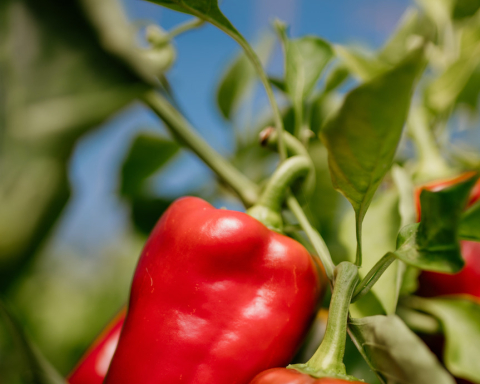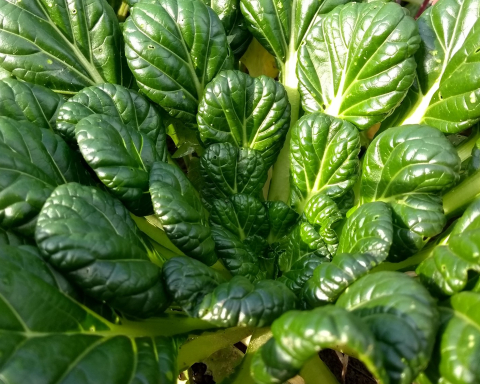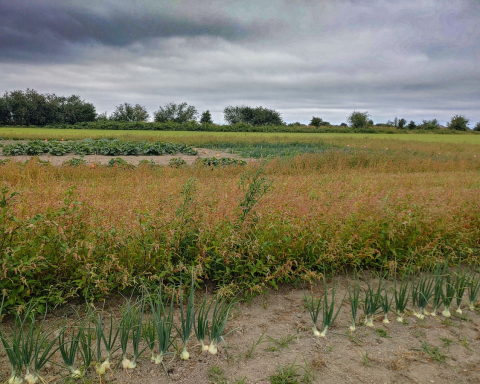Improving Poultry Rations to Accommodate Natural Behaviours & Strengthen Supply Chains
Marjorie Harris
COR Section 6.4: Livestock feed
6.4.3 – Specific livestock rations shall take the following into account:
j) poultry and pigs shall be given vegetable matter other than grain;
k) poultry shall be fed daily…
Why did the chicken cross the road? To eat organic greens of course!
It is well understood that a very important natural behaviour of a healthy and happy hen’s lifestyle is to scratch and peck vegetation and dirt.
The COR standard 6.4.3 (j) states that poultry shall be given vegetable matter other than grain and (k) states they be fed daily.
While the wording and use of language of this standard has led to many confused looks and interpretations by the industry, the intent of this standard is to support the natural behaviours of poultry. It also begs the question, what kind of vegetable matter for poultry?
Thankfully, at the Roundtable Q & A session held at this years’ COABC conference, Anne Macey shared information to help clarify the standards pertaining to poultry nutrition and natural behaviours and how they relate to outdoor access, pasture, and vegetables.
Anne suggested an appropriate interpretation for the term ‘vegetable matter,’ would be ‘green matter,’ and that the simplest solution is to hang sufficient alfalfa/grass hay mesh bags/baskets in the barns for the birds to peck.
The reasons why the hanging hay bag/basket is the simplest and potentially the only current solution for providing green matter on a daily basis in today’s organic poultry industry are discussed here, including the supply chain disruption for organic alfalfa pellets.
Pasture constitutes one possible source of green matter. However, there are several limitations that affect the amount of time green matter can be consumed on pasture, such as weather conditions, season, and vegetation cover. Pasture vegetation can quickly be degraded to dirt by flocks eagerly scratching and pecking.
Requirements for outdoor access, and access to rotational pasture, contained in 6.7.1 (a & j); 6.13.1 (c (2)) are sometimes mistakenly thought to meet the green matter provision. Anne Macey pointed out that these standards also present many limitations for accessing green matter on a daily basis.
Outdoor access during inclement weather can be achieved using winter gardens that typically have sand or sawdust for scratch and no vegetation. Pullets can be kept indoors during vaccination programs and never see the light of day and then be placed directly into layer barns and continue to be kept indoors until peak egg production around 26 weeks of age. The COR standard 6.13.1 (f) only speaks to laying flocks having access to outdoors as little as one-third of laying life. The standards pertaining to outdoor access, and access to pasture, are clearly insufficient to account for the daily green matter provisions of 6.4.3 (j & k).
The overarching standard COR 6.4.3, ‘Specific livestock rations shall take the following into account,’ is interpreted in (j) to refer to the natural behaviours exhibited by the animal while feeding.
The next step is to determine what kinds of green matter would be suitable for use in the various types of poultry operations: ducks, turkeys, broilers, pullets, and layer hens. This is where the application of the standards becomes more complex.
The first thing to consider is that rearing a small flock of less than 200 birds and rearing a large flock of 200 to 10,000 or more birds employ entirely different animal husbandry barn setups, with each method presenting its own set of challenges.
Small flocks are typically part of a mixed farm production unit and poultry will benefit from on-farm garden and orchard waste throughout the growing season. Small scale farms that overwinter poultry can provide a wide range of green matter from hay to sprouted fodder. Large flocks regulated under the egg marketing boards are the main production units of the farm and are raised under tight biosecurity regulations in comparison to small scale farms.
Livestock feed suppliers across Canada are governed by the Feed Act regulations which adds one more wrinkle to how green matter can be supplied in feed. BC feed producers produce a ‘coarse mash’ complete nutrition feed. In contrast, the Ontario poultry feed industry has switched over to a completely ‘pelleted’ complete nutrition feed.
Leanne Cooley, MSc., Poultry Scientist, working in the Ontario poultry industry, described how green matter is provided both as a feed ingredient, and as hay for natural behaviour. Dehydrated alfalfa is mostly indigestible by poultry and when it is included in the pelleted feed certain enzymes must be included to assist in the digestion of alfalfa. According to Cooley, “Insoluble grit is provided either as, or in combination, in free choice feeders and/or in the hens feed to assist in forage digestion and prevent birds developing impacted crops. Hay (second or third cut preferred), alfalfa, or hay-alfalfa blend may be done hanging in mesh bags or baskets, or scattered as litter. I see both. Warning —do not use straw!”
Hanging alfalfa or grass hay in mesh bags or baskets is a good method for accommodating the birds’ need to fulfill natural behaviors for scratching and pecking on a daily basis. When alfalfa/grass hay is made available to the birds early in life it can help to reduce and prevent the poultry pecking behavior that results in bird cannibalism.
Hanging the hay in bags or baskets will also keep the hay clean and out of any moving parts of larger egg layer operations. Pullet and broiler operations typically provide the hay as litter which doubles as scratch.
Organic alfalfa pellets are also a good, clean, sterilized source for ‘green matter.’ Unfortunately, there has been a supply chain shortage and currently there are no organic alfalfa pellets available from Western Canadian producers. The supply chain has suffered in the past few years due to an inappropriately applied ‘commercial availability’ clause in the PSL Can-CGSB 32-311 Table 4.2. This clause, without proper scrutiny, has become a loophole allowing crop producers to use no-spray and non-gmo alfalfa meal and pellets at lower cost. This left only livestock producers in place to purchase organic alfalfa pellets, and not able to create enough demand on the supply chain to keep it healthy in Western Canada. The Ontario supply chain is strong with Ontario Dehy Inc. supplying the Ontario poultry farmers with organic alfalfa pellets.
Western Alfalfa Milling Company (WAMCO) is a pioneer in the industry and grows and processes alfalfa near Norquay, Saskatchewan. WAMCO is certified organic to produce organic alfalfa meals, pellets, and hays. However, due to the misapplication of the commercial availability clause noted above the greater demand was for conventional alfalfa pellets as green fertilizer and mulch. WAMCO had to make a ‘supply and demand’ business decision this year to downsize alfalfa pellet production in 2020 from 60,000 tons a year to just 6,500 tons a year, with a focus on the conventional green fertilizer market. WMACO sales representative, April Guertin, shared some industry history, noting that 20 years ago there were 48 alfalfa pellet producers in Canada, shrinking down to only 3 producers in 2019, with only Ontario Dehy Inc. and WAMCO being certified organic. WAMCO gave assurance that if requests for organic alfalfa pellets were placed now at the beginning of the 2020 growing season, then WAMCO could certainly fill the orders for poultry and crop producers.
In summary, the intention behind COR 6.4.3 (j & k) is that poultry shall be given rations of green matter with respect to meeting their natural behavior needs for pecking and scratching daily. Options that would work for both small and large scale producers include alfalfa/grass hays hanging in bags or baskets and as litter and alfalfa pellets. Livestock producers need to be aware of keeping supply chains viable, strong, and competitive by ordering product ahead of the growing season. Crop producers can also buy into the organic supply chain, avoiding the misappropriate uses of the ‘commercial availability’ clauses for green fertilizer and mulches, further strengthening supply chains for the entire organic industry.
Marjorie Harris, IOI VO and concerned organophyte.










